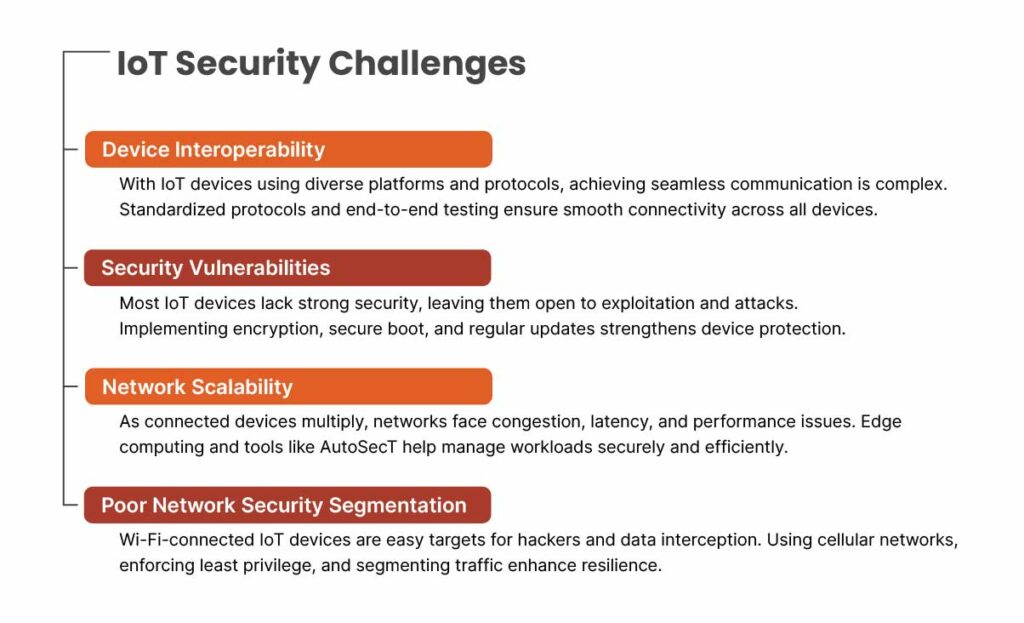The widespread adoption of IoT technologies has greatly improved connectivity and convenience across industries, homes, and infrastructure. Yet, this growth has also brought a range of security challenges stemming from limited device resources, inconsistent protection measures, and expanding attack surfaces. Overcoming these issues demands a thorough understanding of IoT vulnerabilities and the implementation of effective strategies focused on strong authentication, encryption, proactive threat detection, and end-to-end security frameworks.
Currently, there are approximately 17.08 billion IoT-connected devices worldwide—a figure projected to nearly double to 29.42 billion by 2030. This explosive growth signifies a major transformation in how we interact with our surroundings. From smart alarms and washing machines to remotely controlled refrigerators, IoT devices have become integral to daily life. Their software is driving innovation across industries such as logistics, retail, energy, IT infrastructure, and autonomous vehicles. By connecting everyday objects to the Internet, the Internet of Things (IoT) is reshaping how we live and work through real-time data exchange and automation.
As IoT adoption accelerates, the need for robust IoT software testing becomes increasingly critical to ensure these devices operate securely, efficiently, and reliably. This article explores the importance of IoT testing, the key challenges it addresses, and practical strategies businesses can implement to stay ahead in this rapidly evolving digital landscape. This article highlights the most common IoT security challenges and offers practical solutions to mitigate risks and enhance IoT resilience.
Table of Contents
Challenges in IoT Security for Organizations
Organizations adopting IoT face several security challenges that can compromise data integrity, privacy, and operational continuity. Some of the most critical include:

Device Interoperability
Ensuring seamless interoperability among a vast array of devices from multiple vendors remains a significant challenge. IoT devices often operate on different platforms, use diverse communication protocols, and function across varied environments. Achieving smooth connectivity and coordination between these devices is essential for the success and reliability of any IoT initiative.
Solution: Establishing Standard Protocols and Comprehensive Testing Frameworks
Standardized communication protocols play a crucial role in addressing interoperability challenges. Protocols like MQTT, CoAP, and Zigbee facilitate efficient and reliable communication between devices. To minimize interoperability issues, organizations should implement a comprehensive testing framework that includes end-to-end testing, compatibility testing, and real-world simulations.
Security Vulnerabilities
Security remains one of the most significant challenges in IoT implementation. Research by HP reveals that around 70% of IoT devices contain vulnerabilities that can be exploited by attackers. Due to their limited processing power and resource constraints, many IoT devices are unable to support security mechanisms, making them vulnerable to hackers.
Solution: Enforcing Strong Security Measures and Consistent Updates
To minimize security risks, organizations must implement strong security protocols right from the design phase. This involves incorporating data encryption, secure boot mechanisms, and regularly updating firmware. Integrating penetration testing and vulnerability assessments into the continuous integration and deployment (CI/CD) pipeline further strengthens IoT security. Platforms like IBM Watson IoT Platform and Microsoft Azure IoT Suite provide comprehensive security capabilities and regular updates to help safeguard IoT ecosystems effectively.
Network Scalability
As the number of connected devices continues to grow, maintaining a scalable network becomes increasingly challenging. High device density can lead to network congestion, latency issues, and increased data traffic, all of which can negatively impact the overall performance of IoT systems.
Solution: Edge Computing and Intelligent Network Management
Edge computing helps overcome these challenges by processing data closer to its source, reducing latency, and alleviating the burden on central servers. Offloading data processing to the edge allows networks to efficiently handle larger workloads. Alongside this, modern network management and security testing tools play a crucial role in maintaining performance and resilience. AutoSecT, for instance, enhances IoT security by automating vulnerability detection and validation, ensuring that connected devices remain secure as networks scale.
Poor Network Security and Segmentation
Because many IoT devices rely on Wi-Fi networks, they face a heightened risk of cyberattacks such as eavesdropping on network traffic or unauthorized access to sensitive data. In contrast, cellular networks offer stronger security by design, incorporating advanced protection mechanisms and being managed by dedicated security teams within network operations centers. IoT devices connected through cellular networks are therefore less vulnerable to local threats like rogue access points, Wi-Fi sniffing, or network intrusions, as they operate outside traditional LAN environments.
Solution: Enhancing IoT Resilience with Secure Network Architecture
Using cellular networks instead of Wi-Fi or Bluetooth enhances IoT security through built-in encryption, secure remote management, and carrier-level monitoring for faster threat detection and response. Organizations should also enforce the principle of least privilege, granting users and devices access only to essential systems to limit the impact of potential breaches. Additionally, network segmentation helps isolate IoT devices from critical infrastructure, restrict unnecessary communication, and improve visibility and anomaly detection across the network.
Get in!
Join our weekly newsletter and stay updated
Best Practices of IoT Security Testing
Adopting strong security measures is crucial to safeguarding IoT devices, data, and networks against the growing sophistication of cyber threats. Organizations should take a holistic approach to securing IoT ecosystems throughout their lifecycle by collaborating with reliable connectivity providers, prioritizing user privacy, and utilizing secure cellular networks for enhanced protection.
Endpoint IoT Protection
A crucial aspect of IoT security is strengthening devices through IoT endpoint protection. This process involves addressing vulnerabilities in high-risk areas such as Transmission Control Protocol (TCP), User Datagram Protocol (UDP), wireless interfaces, and unencrypted communications, while also defending against malicious code injection.
Implementing endpoint protection helps organizations shield their networks from sophisticated cyberattacks, including modern malware and ransomware. It also secures devices at the network edge, giving security teams full visibility into connected endpoints, real-time insights into network activity, and a reduced overall attack surface.
Securing IoT Gateways
Organizations can enhance IoT protection by implementing IoT gateway security, which enforces internet access controls and blocks unauthorized or malicious software—such as malware—from compromising device connections.
A Secure Web Gateway (SWG) plays a key role in this defense by offering capabilities like application control, deep HTTPS and SSL inspection, remote browser isolation, and URL filtering. As enterprises increasingly adopt cloud environments and enable remote connectivity, these measures help mitigate web-based threats and safeguard IoT devices from both external and internal attacks.Additionally, incorporating threat monitoring solutions and virtual private networks (VPNs) strengthens connection security by detecting potential data leaks, encrypting browsing activity, and protecting users from cyber eavesdropping.
Protecting Cloud APIs
Cloud Application Programming Interfaces (APIs) serve as the communication bridge between IoT applications and systems, facilitating seamless data exchange and integration. However, any compromise or misconfiguration in these APIs can lead to significant data breaches. To prevent such risks, securing cloud APIs through strong authentication mechanisms, encryption, tokens, and API gateways is essential. Web API security ensures safe data transmission over the internet, while REST APIs protect information by encrypting data and connections between servers and devices.
Building a Secured Network
Establishing a secure network connection is crucial to enforcing proper access control, ensuring that only verified and authenticated devices can connect to the network. Network security starts with configuring a strong firewall and implementing protective measures such as multi-factor authentication (MFA) to verify users each time they attempt access. Additionally, safeguarding authentication keys, keeping antivirus and antimalware software up to date, and continuously monitoring network activity are vital steps to maintain the security of both devices and users.
Book Your Free Cybersecurity Consultation Today!
How Kratikal Can Help You Mitigate IoT Challenges?
Kratikal’s IoT security testing services provide organizations with a structured, end-to-end approach to addressing IoT risks, starting with scoping and attack-surface mapping, followed by vulnerability analysis, exploitation simulation, and comprehensive reporting. Through methods such as firmware analysis, threat modeling, and full device-to-cloud penetration testing, Kratikal exposes hidden vulnerabilities in devices, communication channels, and back-end infrastructure. This helps enterprises implement precise remediation strategies, reduce operational costs, strengthen security controls, and gain visibility into their IoT ecosystem enabling them to confidently roll out connected devices in a secure, compliant manner.
FAQs
- What is the main reason for the lack of security in IoT devices?
Many IoT devices depend on weak authentication and authorization mechanisms, leaving them exposed to potential threats. In numerous cases, devices still operate with default passwords, providing an easy entry point for attackers to compromise both the devices and the networks they communicate with.
- What is a common security challenge in IoT devices?
Key challenges in IoT security stem from weak or default passwords, unencrypted communication channels, and outdated or non-upgradable firmware. Additionally, inadequate device management, insecure APIs and user interfaces, and poor physical security further increase the risk of data breaches, malware infections, and unauthorized system access.








Leave a comment
Your email address will not be published. Required fields are marked *